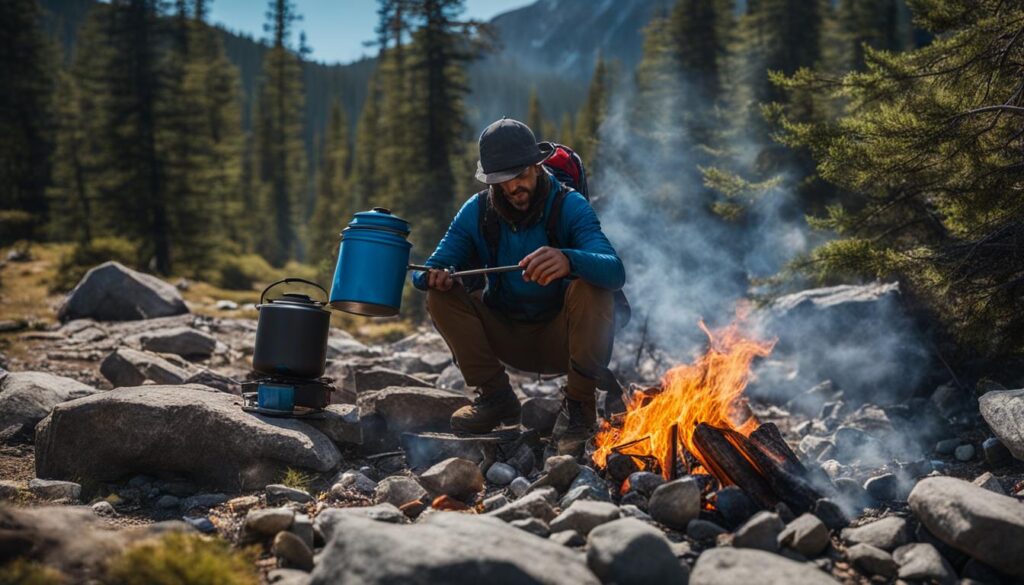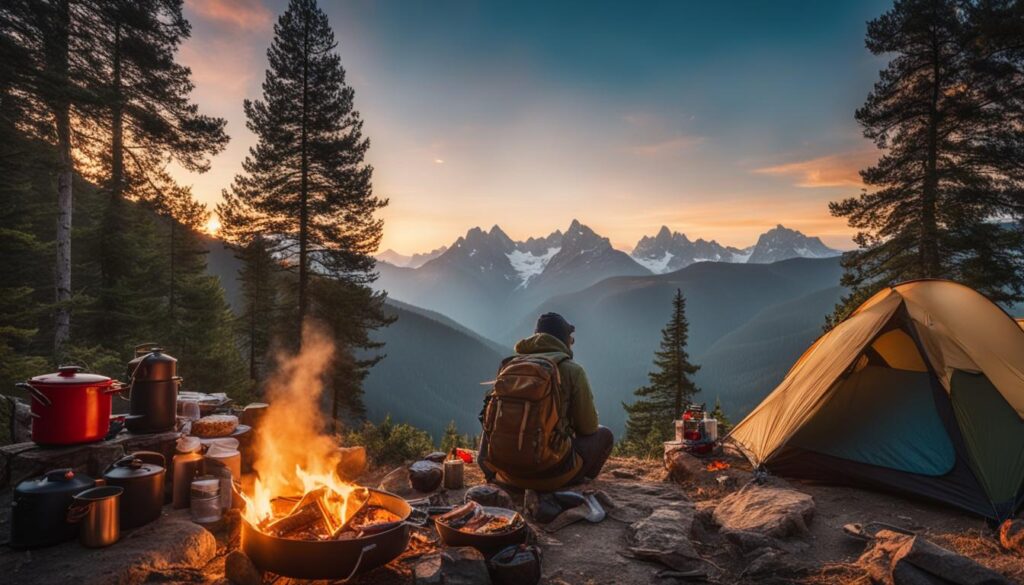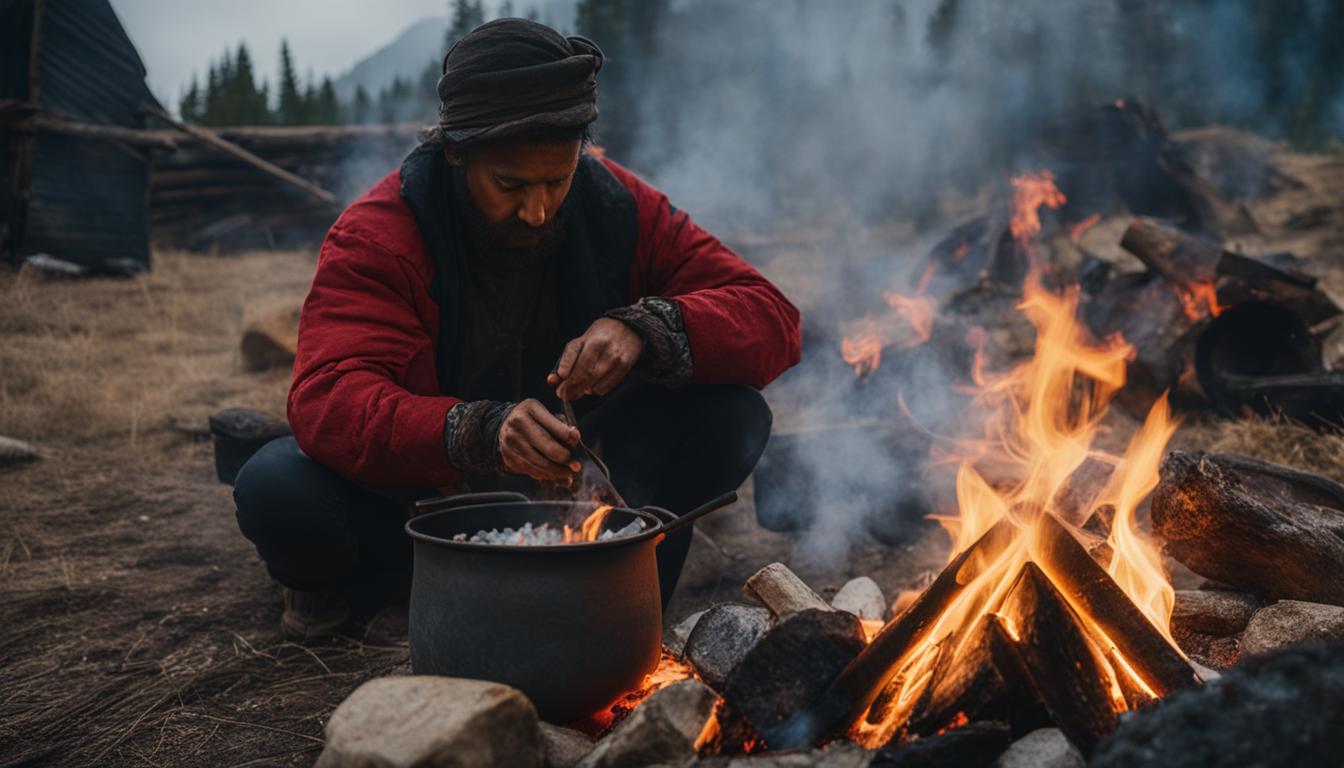Cooking meals while backpacking is an essential skill for outdoor enthusiasts like me. It not only elevates your adventure but also provides delicious and nutritious meals on the trail. With the right backpacking cooking skills, you can enjoy a variety of meals, efficiently plan your meals for backpacking trips, and utilize different cooking techniques to make the most out of your outdoor cooking experience.
Key Takeaways:
- Mastering backpacking cooking skills allows for delicious and nutritious meals on the trail.
- Efficient meal planning is crucial for successful backpacking trips.
- Understanding different cooking techniques enhances the outdoor cooking experience.
- Backpacking cooking skills enable a variety of meal options for backpacking adventures.
- Proper backpacking cooking skills ensure safety and efficiency during meal preparation.
Essential Cooking Gear for Backpacking Trips
When it comes to backpacking cooking, having the right gear is crucial. The right equipment can make a significant difference in the efficiency and enjoyment of your outdoor cooking experience. Here are the essential cooking gear items you should consider for your backpacking trips:
Camping Stove
A lightweight camping stove is a must-have for backpacking. Look for a compact and portable stove that is fuel-efficient and easy to use. There are various types of camping stoves available, including canister stoves, liquid fuel stoves, and wood-burning stoves. Choose one that best suits your needs and preferences.
Cookware
Invest in lightweight and durable cookware for your backpacking trips. Consider a lightweight saucepan and mug that are compact and easy to pack. Look for cookware made from materials like titanium or aluminum, as they are lightweight and conduct heat well. Opt for non-stick cookware to make cleaning up a breeze.
Utensils
Don’t forget to pack essential utensils for cooking and eating. A long-handled spoon is perfect for stirring and serving meals, while a foldable spatula can come in handy for flipping pancakes or cooking meat. Look for lightweight and durable utensils that are designed for outdoor use.
Food Storage
Proper food storage is essential for backpacking trips. Invest in food storage containers that are lightweight, leak-proof, and space-saving. Look for containers that are designed to keep your food fresh and protected from any potential leaks or spills. Consider using resealable bags for storing snacks and smaller food items.
By having the right cooking gear, you can ensure that you have everything you need to prepare delicious meals while enjoying the great outdoors. Remember to pack your gear strategically to save space and reduce weight, allowing you to fully enjoy your backpacking adventure.
Simple and Nutritious Backpacking Meal Ideas
Dehydrated Meals
When it comes to backpacking meal ideas, dehydrated meals are a popular choice among outdoor enthusiasts. These lightweight and convenient meals are easy to prepare and come in a variety of flavors, making them a versatile option for backpacking trips. Whether you prefer classic dishes like pasta and rice or more adventurous flavors like Thai curry or Mexican chili, there is a dehydrated meal to satisfy every palate.
Dehydrated meals are also a great option because they require minimal cooking equipment. All you need is boiling water and a stove or campfire to rehydrate the meal. This saves you time and energy, allowing you to focus on enjoying your adventure rather than spending hours preparing and cooking meals.
Homemade Meals
If you prefer a more personalized touch to your backpacking meals, homemade meals are an excellent option. With a dehydrator or by assembling dried ingredients, you can create your own customized backpacking meals. This allows you to control the ingredients, flavors, and portion sizes according to your preferences and dietary restrictions.
Some popular homemade backpacking meals include dehydrated soups, pasta dishes, and stir-fries. By dehydrating your own ingredients such as vegetables, meats, and grains, you can create nutritious and flavorful meals that are tailored to your taste buds. Homemade meals also give you the opportunity to experiment with different flavors and combinations, adding a sense of adventure to your backpacking experience.
Trail Mix
In addition to dehydrated and homemade meals, don’t forget to pack trail mix for quick and energizing snacks on the trail. Trail mix is a staple for backpackers as it provides a boost of energy from its blend of nuts, dried fruits, and sometimes chocolate or other sweet treats. It is lightweight, portable, and doesn’t require any cooking, making it a perfect on-the-go snack.
You can customize your trail mix by adding your favorite ingredients such as almonds, cashews, dried blueberries, or dark chocolate chunks. It’s a versatile snack that can keep you fueled and satisfied throughout your backpacking adventure, whether you’re hiking, climbing, or simply enjoying the great outdoors.
Table: Comparison of Backpacking Meal Options
| Meal Option | Pros | Cons |
|---|---|---|
| Dehydrated Meals | – Lightweight and easy to pack – Variety of flavors available – Minimal cooking equipment required |
– Can be expensive – Some meals may have artificial ingredients – Limited customization options |
| Homemade Meals | – Customizable to personal preferences – Control over ingredients and portion sizes – Can be more cost-effective |
– Requires more preparation time – Additional cooking equipment may be needed – Limited shelf life |
| Trail Mix | – Lightweight and portable – Provides quick energy – No cooking required |
– High calorie content – May not provide a balanced meal – Allergic reactions to nuts or other ingredients |
When planning your backpacking meals, consider incorporating a mix of dehydrated meals, homemade meals, and trail mix to ensure a balanced and enjoyable dining experience on the trail. Experiment with different flavors, ingredients, and combinations to find what works best for you. Remember to always pack enough food to sustain you throughout your trip and stay hydrated by drinking plenty of water. With these simple and nutritious backpacking meal ideas, you’ll be well-prepared to fuel your outdoor adventures.
How to Cook Safely and Efficiently While Backpacking

Cooking safely and efficiently while backpacking is crucial to ensure a successful and enjoyable trip. By following proper cooking safety guidelines, optimizing fuel efficiency, and practicing effective meal preparation, you can have a hassle-free cooking experience in the great outdoors.
Ensure Cooking Safety
When cooking while backpacking, it’s essential to prioritize safety. Choose a stable cooking surface that is away from flammable objects, such as dry leaves or overhanging branches. Always keep a safe distance from your cooking area and maintain a fire extinguisher or water source nearby in case of emergencies. Additionally, be cautious when using open flames and never leave your cooking equipment unattended.
Optimize Fuel Efficiency
Maximizing fuel efficiency is crucial to conserve resources and reduce the weight of your backpack. Consider using a windscreen to shield your stove from wind, as it can significantly improve its efficiency. Choose fuel types that are suitable for your needs and the environmental conditions of your trip. For shorter trips, lightweight canister stoves are a popular choice, while liquid fuel stoves are preferred for longer expeditions.
Practice Effective Meal Preparation
Proper meal preparation is essential to prevent foodborne illnesses and ensure that your meals are enjoyable and nutritious. Store your food in airtight containers to prevent spoilage and contamination. When handling raw meats, be sure to clean your hands and any utensils or surfaces that come into contact with the meat to prevent cross-contamination. It’s also a good idea to pre-measure and package ingredients for each meal to save time and simplify the cooking process on the trail.
By following these tips for cooking safely and efficiently while backpacking, you can have a memorable and satisfying outdoor cooking experience. Remember to always prioritize safety, use fuel wisely, and practice effective meal preparation to ensure a successful journey.
Tips for Meal Planning on Backpacking Adventures

When embarking on a backpacking adventure, meal planning is a crucial aspect to consider. Proper meal planning ensures that you have enough food to sustain you throughout your trip and provides you with the necessary energy for your outdoor activities. To help you with your meal planning, here are some tips to keep in mind:
Consider your food supply
First and foremost, assess the duration and intensity of your backpacking trip. This will help you determine how much food you need to bring along. Consider the number of days you’ll be on the trail and the amount of physical activity you’ll be engaging in. It’s important to have a sufficient food supply to meet your calorie needs and avoid running out of nourishment during your adventure.
Calculate your calorie intake
Calculating your calorie intake is essential for meal planning on backpacking trips. Take into account your daily energy expenditure based on your activity level and the demands of your hike. This will guide you in determining the number of calories you should aim to consume each day. It’s advisable to pack high-calorie, nutrient-dense foods that are lightweight and easy to prepare.
Create menu variety
Keeping your meals interesting and diverse is key to avoiding monotony during your backpacking journey. Aim for menu variety by including a combination of dehydrated meals, homemade meals, and snacks. Dehydrated meals are lightweight, convenient, and come in a variety of flavors. Additionally, consider packing trail mix, energy bars, and dried fruits for quick and easy snacks on the trail.
| Meal Type | Examples |
|---|---|
| Breakfast | Instant oatmeal, granola, or breakfast bars |
| Lunch | Peanut butter and jelly sandwiches, tortilla wraps, or instant noodles |
| Dinner | Dehydrated pasta, rice, or couscous meals |
| Snacks | Trail mix, energy bars, dried fruits, or jerky |
By following these tips, you can effectively plan and prepare your meals for your backpacking adventures. Remember to pack enough food, calculate your calorie intake, and create menu variety to ensure a nourishing and enjoyable experience while exploring the great outdoors.
Backpacking Techniques for Cooking
When it comes to cooking meals on the trail, backpackers have developed various techniques to ensure delicious and satisfying meals without the need for extensive cooking equipment. Here are some backpacking techniques, including cold soaking and flavor enhancements, that can elevate your outdoor cooking experience.
1. Cold Soaking
Cold soaking is a popular method among backpackers for preparing simple, no-cook meals. This technique involves rehydrating dried ingredients in water without the need for cooking. It is particularly useful for meals like pasta salad or overnight oats. To cold soak, simply place your dried ingredients in a container, add water, and let them soak for several hours or overnight. The ingredients will rehydrate and become ready to eat without any additional cooking time or fuel consumption. Cold soaking is not only convenient but also preserves the nutritional value of the ingredients.
2. No-Cook Meals
In addition to cold soaking, there are plenty of no-cook meal options for backpackers. These meals require minimal preparation and are great for saving fuel and time on the trail. Some popular no-cook meal ideas include wraps with pre-cooked meat or cheese, trail mix with nuts and dried fruits, or energy bars. No-cook meals are ideal for shorter trips or when you are looking for quick and easy meal options without the need for cooking equipment.
3. Flavor Enhancements
While backpacking meals can be nutritious, they can sometimes lack flavor. To enhance the taste of your meals, consider adding flavor enhancements such as spices, oils, and sauces. Lightweight and compact containers can be used to carry small portions of your preferred spices, like salt, pepper, or chili flakes. Additionally, small bottles of olive oil or sauces can be a game-changer for adding flavor to your meals. Just a small drizzle or sprinkle can transform a simple dish into a satisfying and flavorful meal.
By utilizing techniques like cold soaking, opting for no-cook meals, and incorporating flavor enhancements, you can expand your backpacking cooking repertoire and enjoy delicious meals on the trail without the need for extensive cooking equipment. These techniques not only save valuable backpack space and reduce cooking time but also allow you to explore a wide variety of flavors and enjoy hassle-free meals during your outdoor adventures.
Conclusion
As an outdoor enthusiast, mastering backpacking cooking skills is essential for a successful adventure. The ability to prepare delicious and nutritious meals on the trail is a game-changer. By arming yourself with the right gear, honing your meal planning techniques, and experimenting with different backpacking cooking methods, you can elevate your outdoor cooking game and enhance your overall experience.
Outdoor cooking is all about finding the perfect balance between simplicity and flavor. With the right skill set, you’ll be able to whip up tasty meals that fuel your body and satisfy your taste buds. Whether you’re using dehydrated meals, creating homemade delicacies, or opting for no-cook options, there are endless possibilities to explore.
Remember, safety and efficiency are paramount when cooking in the great outdoors. Always prioritize fire safety, choose fuel types that suit your needs, and handle food properly to prevent any foodborne illnesses. Additionally, effective meal planning ensures you have enough food to sustain you throughout the trip and provides a variety of options to keep your taste buds excited.
So grab your backpacking gear, embrace the wilderness, and embark on incredible culinary adventures. With your newfound cooking skills, you’ll be able to savor the flavors of the great outdoors and create lasting memories on your backpacking journeys. Happy cooking!
Can the Cooking Techniques for Backpacking Over a Campfire Also Apply to Other Backpacking Cooking?
Yes, the cooking techniques for backpacking over a campfire can definitely apply to other backpacking cooking. Whether it’s using lightweight cookware, preparing meals in advance, or practicing Leave No Trace principles, the same backpacking cooking techniques can be used for various outdoor cooking situations.
FAQ
What cooking gear do I need for backpacking trips?
Essential cooking gear for backpacking trips includes a lightweight camping stove, compact cookware such as a saucepan and mug, long-handled spoon, and food storage containers.
What are some simple and nutritious backpacking meal ideas?
Dehydrated meals are a popular choice for backpackers as they are lightweight, convenient, and come in a variety of flavors. You can also create homemade meals using a dehydrator or by assembling dried ingredients. Don’t forget to pack trail mix for quick and energizing snacks on the trail.
How can I cook safely and efficiently while backpacking?
Always follow proper cooking safety guidelines, such as using a stable cooking surface and keeping a safe distance from flammable objects. Optimize fuel efficiency by using a windscreen and choosing fuel types that suit your needs. Proper meal preparation, including food storage and handling, is crucial to prevent foodborne illnesses.
How should I plan meals for backpacking adventures?
Consider the duration and intensity of your trip when planning food supply. Calculate your calorie intake based on your activity level and pack enough food to sustain you throughout the trip. Aim for menu variety by including a mix of dehydrated meals, homemade meals, and snacks to keep things interesting.
What backpacking techniques can I use for cooking?
Cold soaking is a popular method for simple no-cook meals like pasta salad or overnight oats. This technique involves rehydrating dried ingredients in water without the need for cooking. You can also enhance the flavors of your backpacking meals by adding spices, oils, and sauces for a more enjoyable dining experience.

